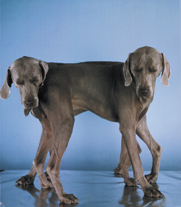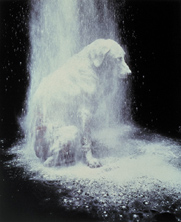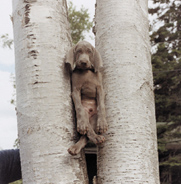By:
Angelle Bergeron
|
William Wegman
His photographs have been the source of inspiration, entertainment and scorn for everyone from the upper echelons of the art world to the boy next door. He is a veritable icon of popular culture and the envy of anyone in search of a muse.
William Wegman has managed to secure the enviable position of excelling in his art, with the added perk of taking his dogs to work every day.
In some ways his story replicates that of dog lovers everywhere – an almost obsessive fascination with the quirks and personality traits of his beloved – yet Wegman is able to capture those images and relate them in a unique way, capturing our imagination in the process.
Wegman was already an accomplished artist in 1970 when he began photographing his beloved weimaraner, Man Ray, and was catapulted into the limelight of the masses. Often referred to as the comic prince of modernism, Wegman said he doesn’t find the success of his Man Ray work surprising. “Because of the art movement in the late 60s, the work that was out there was rather intense, boring or self-indulgent,” he said recently during a phone interview from his studio in New York. “Mine had a humor and brevity that sort of helped the audience get it. It had a gentler spirit than what is usually behind conceptualism and minimalism, which was a bit more aggressive to the viewer.”
The muse for that gentler spirit was the dog Man Ray.
The story of how Wegman and Man Ray came into each other’s lives began when the artist’s wife, Gail, decided she wanted a large, short-haired dog, possibly a Dalmatian or German Short hair pointer. “We came across an ad for weimaraners for $35. We flipped a coin and got this dog,” Wegman said. “I named him Man Ray and he hung out with me all the time.”
Living in California at the time, Wegman had just diverted from his painting to embark on video and photo work. “My studio was in transformation, and I was very excited about the video and photo work,” Wegman said. “Out of curiosity, he kept coming over. I just sort of set him up in a pose or two. He seemed to really crave the attention. I liked what I was seeing, and he liked what I was doing, so I continued.”
Wegman’s voice trailed off in what couldn’t have been a more emphatic underscoring of his continued admiration and mourning for the dog. “At the age of 12, he died in 1982. I didn’t get another dog for five years.”
In 1978, Polaroid had invented the 20x24, designed to take life-size portraits in an instant. Before using the Polaroid, Wegman had preferred black and white in images no larger than 11x14. He rather distrusted color until the experimental, 1979 “Fey Ray” photo that features Man Ray, posed against a black background with his toenails polished a brilliant red. Once again, his muse had inspired him to grow.
As Man Ray’s health began to decline and he lost his chiseled, physical appearance, Wegman moved from the straightforwardness consistent with minimalism and worked more on eliciting expressions from the dog. Of the 1982 “Rouge,” he wrote, “Man Ray looks soft and fragile, physically and psychologically. This picture makes me remember him more intimately than any other. His feet smelled like movie popcorn.”
Wegman met his next dog and subject (by chance or fate, he said) in Tennessee, when she was six months old and her name was Cinnamon Girl. He didn’t want to mar the memory of Man Ray with the presence of another dog. He named her Fay Ray, after the 1979 photo “Fey Ray.”
Her fur was taupe, lighter and warmer-toned than the almost black Man Ray. Because she was so different, obviously not Man Ray, it was okay to shoot her, Wegman told himself. He took his first photos of her in 1987, when Fay was just over a year.
When Wegman brought Fay to the studio, she, like Man Ray, wanted to pose. “I was 17 years older than when I started with Man Ray,” Wegman said. “More importantly, I started to use this Polaroid that uses a difficult set up, a lot of light, assistance. The work started to be a collaboration between the dog and these crazy things I was using her for.”
At one point, Wegman recalled, he put her on a table and started to drape things on her like she was a column or some other piece of architecture. One day, when an assistant was draping something over Fay, Wegman liked the way her arms looked like they belonged on the dog, and he shot that. “I really avoided anthropomorphic work in the earliest years because of parallels to a certain Bud Light ad with a dressed up dog. The whole idea was that he looked comic and ridiculous. I don’t mind humor, but I didn’t want to make something ridiculous out of these noble creatures.”
Wegman described Fay as Garboesque, very elegant, glamorous, severe, aloof and kind of spooky. “Fay made me laugh because she took her job so seriously that she appeared to be almost psychotic,” he said. “Fay would stand, look right at the camera as if to say, ‘Is that the way you want me to do it?’”
After Fay came a string of weimaraner subjects, dressed and posed in every way imaginable as Wegman elicited each model’s personality and shared them with the world.
As his popularity soared, the art world fled. “When you begin to expand your audience outside of the art world, that is one thing the art world hates,” he said. However, the worst criticism Wegman ever endured has been from dog lovers. “It used to bother me when people would say I was abusing the dogs, and that is something I am very adamant about and sure I’m not. I suppose some of the shots may look troubling, but you don’t get an 80-pound dog to do what it doesn’t want to do, especially over and over again.”
When one sees the different poses favored for each dog and their expressions, Wegman’s insight seems obvious. His fondness for the breed is tremendous. Wegman describes weimaraners as “kind of mysterious, spooky, like aliens, but also beautiful.” He speaks at length about the idiosyncrasies of each of the dogs he has photographed. “Dotty made me smile. She had such a silent way of doing everything,” Wegman said. “That’s why, when Dotty died, it broke me up so much, because she was so vulnerable and sweet and you had to take care of her.”
Wegman described Batty (the fairy tale heroine of many of his children’s books) as having an uncanny sense of comic timing, like Carol Lombard or Goldie Hawn. He described Chundo, Fay’s first born male, as “the prince, the king, the wolf, the woodsman, the man. His masculinity anchors every picture he is in.” Chundo has been on more magazine and calendar covers than any of Wegman’s other dogs.
Man Ray was stoic. Chip was most handsome, and Candy the most catlike. “I see them all as they are and the shades of their personality come out in the work,” Wegman said.
Regarding the breed’s disposition, Wegman admitted they demand a lot of attention. “Man Ray was six weeks when I got him, and he was very demanding. He would howl in the corner when I would try to tie him up away from me, but I had all the time in the world to develop a rapport with him.”
He’s had weimaraners that have more energy, are more rambunctious and others that are catatonic until he places the scent of a rabbit or partridge in front of them.
Working with the dogs usually requires one man and one assistant, Wegman said, especially if the dog is in a compromised situation, like on a stool with clothes. At the Polaroid studio, there may be as many as six or eight people at a time.
A big table, about three or four feet off the ground, brings the dogs up to the camera, which weighs about 300 pounds and stands about six feet tall. “The dog is in the pose for maybe 30 seconds while I push them around like they are clay,” Wegman said. “They get rather pliant, some more than others. It’s funny to discover certain ways they won’t do something, or don’t like to do something.”
The dogs usually compete to be on the table, up at Wegman’s level, he said. “They want to be tall.”
Working in this environment has made Wegman gentler and more patient. He can’t yell, or their ears will go back. He can’t coax with treats because they will drool. “The dog is something you can’t manipulate in an aggressive or threatening way so I’ve had to be gentler. My work is somehow sad, wistful or melancholic, but never sort of mean or aggressive.”
Currently, Wegman works with three dogs: Chip, Bobbin and Candy. Last November he lost Batty, one of two daughters of Fay. Candy had a litter of puppies in February, and Wegman is finding it a challenge rearing them in his own studio. “I have a runt that takes constant attention, and I’m taking care of Candy too,” he said. “I’ve called Candy Batty a few times, because the whelping box is right where Batty lay just before she died. She couldn’t really walk, and we had to clean her up. She seemed happy being taken care of, so we kept her until she seemed to be in pain. The doctor came over and gave her an injection and she died peacefully in my arms.”
When he is not in the Polaroid studio, Wegman has numerous other projects to occupy his time. Although he has two shows of his paintings scheduled later this year, is an accomplished writer and film and video maker, Wegman is still most widely recognized for his numerous photographs of his beloved weimaraners. “I have made several pictures without any dogs in them. They tend to be not the ones people are interested in,” he said. “My paintings are the under dog. I don’t go on a TV talk show and show them my paintings.”
Wegman typically spends the summers in Maine, during which he experiments with other formats like digital. “In Maine, I let the dogs run around, call them to attention now and then and take their photo,” he said.
This fall Wegman will have a new release, “Dress Up Batty,” an interactive book with stationery, post cards, stickers and the occasional pop-up. The book is a tribute to the one he recently lost, not an uncommon effort for Wegman. “Every dog I have had has had its own book,” he said.
He will be shooting some puppy photos soon, and plans to spend a lot of time with his two children, ages 9 and 6. “It’s always fun. It’s a full, full life. For a 60-year-old guy, I have a lot going on, a lot of youth and beauty around me.”
|
 |
|

|




